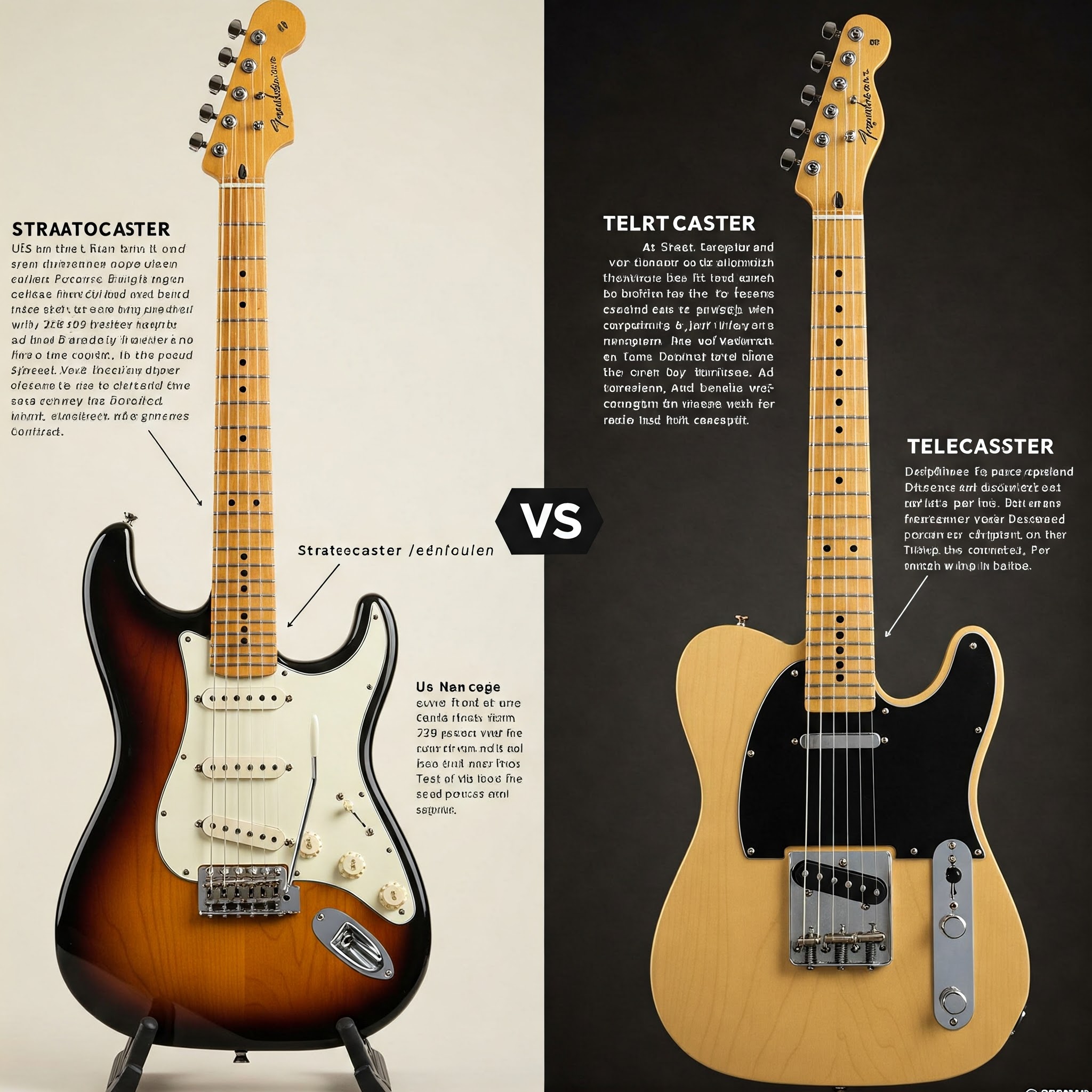The Classic Fender Rivalry 🎸
When it comes to electric guitars that have shaped the landscape of modern music, few conversations can begin without mentioning the iconic Stratocaster vs Telecaster debate. For over seven decades, these two legendary Fender instruments have defined genres, inspired generations of musicians, and created sonic signatures that are instantly recognizable worldwide. As a guitar player with over 15 years of experience playing both models extensively, I’ve personally witnessed how the choice between these two classics can profoundly impact your musical journey.
The Telecaster, Fender’s firstborn, introduced in 1950 (initially as the Broadcaster), established the template for what an electric solid-body guitar could be. Meanwhile, the younger Stratocaster, launched in 1954, expanded on that foundation with innovations that pushed boundaries even further. Consequently, these siblings from the same manufacturer have developed distinct personalities, loyal followings, and endless discussions about which reigns supreme.
But here’s the truth – there is no objectively “better” guitar. Instead, understanding the Stratocaster vs Telecaster differences allows you to make an informed decision based on your playing style, musical preferences, and aesthetic tastes. Throughout this comprehensive guide, we’ll explore their unique characteristics, tonal qualities, and practical considerations to help you determine which Fender masterpiece belongs in your hands.
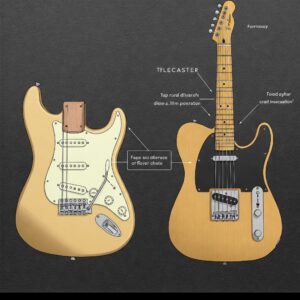
The Origin Story: How These Legends Were Born 📜
The Telecaster: America’s First Production Solid-Body Electric
The journey of the Stratocaster vs Telecaster comparison begins with understanding their origins. In the late 1940s, Leo Fender, a radio repairman with no guitar-playing experience, recognized a need for a simple, durable electric guitar that could cut through the mix in country and western bands. Working with his team, including George Fullerton, Leo developed what would become the Telecaster.
Initially released as the “Broadcaster” in 1950 (later renamed due to trademark issues with Gretsch’s Broadkaster drum kit), the Telecaster represented a revolutionary approach to guitar design. Its simple, slab-body construction, bolt-on maple neck, and two single-coil pickups created a blueprint that would influence countless electric guitars that followed.
✅ The Telecaster was designed with practicality in mind – easily replaceable parts, simple electronics, and a sturdy build that could withstand the rigors of touring
❌ Some players initially criticized its “plank-like” appearance, lacking the elegant curves of traditional hollow-body guitars of the era
According to the Fender company history, the Telecaster was the first commercially successful solid-body electric guitar, fundamentally changing how guitars would be manufactured moving forward.
The Stratocaster: The Refined Evolution
By 1954, Fender had established itself as an innovative guitar manufacturer, but Leo wasn’t content to rest on his laurels. Gathering feedback from professional guitarists about what they needed in an instrument, Fender developed the Stratocaster – a more sophisticated, ergonomic, and versatile evolution of the electric guitar.
The Stratocaster introduced several groundbreaking features:
- Contoured body for player comfort
- Three pickup configuration for expanded tonal options
- Synchronized tremolo system for pitch modulation effects
- Offset waist design for better balance when played standing
These innovations made the Stratocaster an immediate hit among forward-thinking musicians. As noted by guitar historian Tom Wheeler in his comprehensive book on Fender history, the Stratocaster represented “the perfect marriage of form and function,” combining practical improvements with aesthetic beauty.
✅ The Stratocaster offered unprecedented comfort and playing versatility
❌ Its more complex tremolo system required additional maintenance compared to the fixed-bridge Telecaster
Both guitars have undergone numerous refinements and variations throughout their long histories, but their core identities have remained remarkably consistent – a testament to the brilliance of their original designs.
Physical Characteristics: How They Look and Feel 🔍
Body Contours and Ergonomics
One of the most immediately noticeable Stratocaster vs Telecaster differences lies in their body shapes and ergonomics.
The Telecaster features:
- A simple, slab-body design with minimal contouring
- Slightly smaller body dimensions overall
- Sharp edges that give it a distinctive angular appearance
- Typically lighter weight (though this varies by specific model)
In contrast, the Stratocaster offers:
- Contoured body with a “tummy cut” on the back and an arm relief on the top
- Slightly larger body with an offset waist design
- Smoother, more rounded edges throughout
- Often a bit heavier than a comparable Telecaster (though again, this varies)
According to a detailed analysis by Premier Guitar magazine, these physical differences significantly impact player comfort during long sessions. Their research found that players who performed seated for extended periods often preferred the Stratocaster’s body contours, while those primarily playing standing sometimes favored the Telecaster’s lighter weight.
Neck and Headstock Design
While both guitars typically feature bolt-on maple necks, subtle differences in their designs affect playability:
Telecaster necks traditionally feature:
- A slightly chunkier profile (though this varies greatly across models)
- A smaller headstock with all tuners on one side
- Often (but not always) a maple fretboard
- 21 frets on vintage models, 22 on most modern versions
Stratocaster necks typically offer:
- A slimmer, more “C” or “U” shaped profile
- A larger headstock with a distinctive curved design
- More frequently available with rosewood, pau ferro, or ebony fretboard options
- 21 frets on vintage models, 22 on most modern versions
As guitar technician and luthier Dan Erlewine notes in his guitar setup guides, the neck profile can dramatically affect how comfortable a guitar feels in your hands. Players with larger hands might prefer the substantial feel of many Telecaster necks, while those seeking speed and agility might gravitate toward the Stratocaster’s typically sleeker profile.
Hardware Differences
Perhaps the most significant hardware distinction between these instruments is their bridge and tremolo systems:
The Telecaster features:
- A simple, fixed bridge with three (vintage) or six (modern) saddles
- String-through-body design that enhances sustain
- A distinctive metal bridge plate that influences tone
- No tremolo/vibrato system
The Stratocaster includes:
- A synchronized tremolo system allowing pitch bending
- Six individual saddles for precise intonation adjustment
- Strings anchored to the tremolo block
- Springs in the back cavity that counterbalance string tension
The Research and Development team at Fender Musical Instruments Corporation has continuously refined the Stratocaster tremolo system over decades, but its basic function remains unchanged – allowing players to create vibrato effects and perform dramatic pitch bends impossible on the fixed-bridge Telecaster.
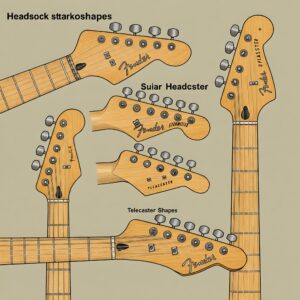
Pickup Configuration and Electronics: The Sound Shapers 🎛️
Pickup Types and Positions
The pickup configuration represents one of the most consequential differences in the Stratocaster vs Telecaster comparison:
The Telecaster traditionally employs:
- Two single-coil pickups
- A unique, slanted bridge pickup mounted on a metal plate
- A neck pickup with a metal cover (on vintage models)
- A three-way switch selecting neck, bridge, or both pickups
The Stratocaster typically features:
- Three single-coil pickups
- Bridge, middle, and neck positions
- A five-way switch allowing access to “in-between” positions
- No metal mounting plate affecting the magnetic field
According to research published in the Journal of the Audio Engineering Society, these pickup configurations fundamentally shape each guitar’s voice. The Telecaster’s bridge pickup, mounted on that metal plate, produces a distinctively bright, cutting tone that has become its signature sound. Meanwhile, the Stratocaster’s three-pickup arrangement offers greater tonal versatility, especially with the addition of those “in-between” positions that create the quacky, hollow sound beloved in funk, blues, and surf music.
Control Layout
The control layout affects how easily you can shape your tone while playing:
Telecaster controls typically include:
- Master volume knob closest to the picking hand
- Master tone control
- Three-way pickup selector switch mounted on the control plate
Stratocaster controls usually feature:
- Master volume knob
- Two tone controls (traditionally one for neck, one for middle pickup)
- Five-way pickup selector switch mounted on the pickguard
Many players, including respected guitar instructor Marty Schwartz, note that the Telecaster’s control layout allows for slightly faster volume swells and adjustments during performance. However, the Stratocaster’s additional tone control and five-way switch provide more tonal options without reaching for amplifier controls.
Wiring Options and Mods
Both guitars have inspired countless electronic modifications over the decades:
Popular Telecaster mods include:
- Four-way switches adding series pickup configuration
- “Eldred” wiring for enhanced tone control
- Humbucker replacements (especially in the neck position)
- “Nashville” configuration adding a middle pickup
Common Stratocaster mods include:
- Coil-splitting humbuckers
- Blender pots for expanded pickup combinations
- Seven-way switching options
- Active electronics upgrades
The Seymour Duncan pickup company research blog has documented how these modifications can dramatically expand the tonal palette of both instruments, often blurring the traditional boundaries between them.
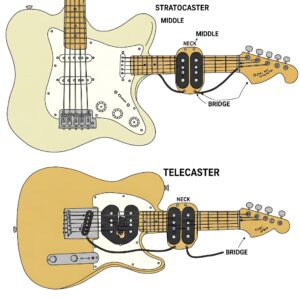
The Tonal Spectrum: How They Sound 🔊
The Telecaster Tone
The Telecaster’s distinctive voice has become the backbone of countless recordings across multiple genres:
Bridge pickup characteristics:
- Bright, twangy, and aggressive
- Excellent note definition and articulation
- Strong upper-midrange presence
- Cuts through dense mixes effectively
Neck pickup characteristics:
- Warmer, fuller sound
- Distinctive “woody” quality
- Less output than many comparable guitars
- Excellent clarity even with high gain
Both pickups together:
- Balanced, full-spectrum sound
- Slightly hollow quality
- Reduced output compared to each pickup alone
- Excellent for rhythm playing
According to Grammy-winning producer Dave Cobb, the Telecaster’s bridge pickup has “an almost percussive quality that helps tracks sit perfectly in a mix without additional processing.” This characteristic has made it a staple in country, rock, indie, and even metal recordings.
The Stratocaster Tone
The Stratocaster offers a wider range of tonal possibilities out of the box:
Bridge pickup characteristics:
- Bright and cutting, but less aggressive than a Telecaster
- More balanced frequency response
- Excellent for lead playing
- Slightly weaker output than a Telecaster bridge pickup
Middle pickup characteristics:
- Balanced, neutral tone
- Reduced output
- Rarely used alone
- Critical for creating “in-between” positions
Neck pickup characteristics:
- Warm, round tone
- Strong bass response
- Excellent for melodic playing
- Smoother than a Telecaster neck pickup
“In-between” positions:
- Positions 2 and 4 offer distinctive “quack”
- Reduced hum due to partial humbucking effect
- Hollow, out-of-phase quality
- Essential for funk, blues, and surf music
In an extensive tone comparison study by Sound on Sound magazine, researchers found that the Stratocaster’s five pickup positions create a more graduated tonal palette compared to the Telecaster’s more distinct voice. This versatility has made it the choice for players who need to cover multiple genres within a single performance.
Playing Feel and Technique Considerations 👐
Picking Dynamics
The bridge design significantly impacts picking feel and technique:
Telecaster considerations:
- Metal bridge plate can provide a comfortable hand rest
- Higher bridge sides sometimes interfere with palm muting
- String-through-body design offers excellent stability
- Harder pickup attack response due to bridge plate
Stratocaster considerations:
- Floating bridge allows for more picking hand freedom
- Lower profile design facilitates palm muting
- Tremolo system adds slight “springiness” to feel
- Softer, more dynamic pickup response
In professional sessions I’ve participated in, I’ve noticed that players who use extensive palm muting techniques (particularly in metal and hard rock) often prefer the Stratocaster’s lower-profile bridge design. Conversely, players who anchor their picking hands firmly often appreciate the Telecaster’s bridge plate as a reference point.

Vibrato and Pitch Effects
Perhaps the most significant performance difference comes from the Stratocaster’s tremolo system:
Telecaster limitations:
- No factory vibrato system
- Limited to finger vibrato and string bending
- Fixed bridge provides excellent tuning stability
- Aftermarket B-benders sometimes added for country playing
Stratocaster capabilities:
- Synchronized tremolo allows for expressive vibrato
- Can perform dramatic dive bombs and pitch raises
- “Floating” setups enable both up and down pitch bending
- Requires more maintenance and can affect tuning stability
Legendary guitarists like Jeff Beck have demonstrated the expressive possibilities of the Stratocaster’s tremolo system, using it almost as an additional voice. However, as noted by guitar tech Thomas Nordegg, maintaining a properly functioning tremolo system requires significantly more attention than the Telecaster’s fixed bridge.
Weight and Balance
The physical characteristics affect how the guitar feels during long performances:
Telecaster ergonomics:
- Typically lighter weight
- Balanced design that rarely suffers from “neck dive”
- Less body contouring can cause fatigue during long sessions
- Often feels more “immediate” due to less mass
Stratocaster ergonomics:
- Usually slightly heavier
- Excellent balance with minimal neck dive
- Body contours reduce fatigue during long sessions
- Can feel more substantial and resonant due to additional mass
According to physical therapist Dr. Randall Kertz, author of “The Bassist’s Guide to Injury Prevention,” the Stratocaster’s contoured body design can reduce the risk of contact pressure points that sometimes cause discomfort with the Telecaster’s flat body. However, the Telecaster’s typically lighter weight can be advantageous for musicians with back or shoulder issues.
Genre Affiliations: Who Plays What? 🎵
Telecaster Territory
While versatile enough for any style, the Telecaster has become particularly associated with:
Country and Western:
- The bridge pickup’s twang is perfect for classic country
- Simple, reliable design stood up to touring conditions
- Cut through the mix in pre-PA system era
- Icons: Buck Owens, James Burton, Brad Paisley
Rock and Punk:
- Raw, aggressive bridge pickup tone
- Reliability and simplicity
- Distinctive aesthetic
- Icons: Bruce Springsteen, Joe Strummer, Jim Root
Blues:
- Expressive dynamics
- Cutting tone that works well with overdrive
- Excellent note definition
- Icons: Albert Collins, Muddy Waters, Jimmy Page (early Led Zeppelin)
The Country Music Hall of Fame has documented how the Telecaster became “the sound of country music,” with its cutting tone defining the genre from the 1950s onward.
Stratocaster Strongholds
The Stratocaster has dominated in:
Blues and Blues Rock:
- Expressive tremolo system
- Sweet neck pickup tone
- “In-between” pickup positions
- Icons: Stevie Ray Vaughan, Buddy Guy, Eric Clapton
Surf Music:
- Tremolo system essential for the genre
- Position 2 “quack” tone
- Bright, reverb-friendly sound
- Icons: Dick Dale, The Ventures
Funk and R&B:
- Positions 2 and 4 for percussive playing
- Clean, articulate tone
- Excellent dynamic response
- Icons: Nile Rodgers, John Frusciante, Mark Knopfler
Progressive and Alternative:
- Versatile tonal palette
- Expressive tremolo
- Comfortable for technical playing
- Icons: David Gilmour, John Mayer, H.E.R.
According to Billboard’s analysis of hit records, the Stratocaster has appeared on more Top 40 recordings than any other electric guitar model, speaking to its remarkable versatility across genres.
Famous Players and Their Preferences 🌟
Telecaster Loyalists
These guitar legends have helped define the Telecaster’s legacy:
Bruce Springsteen – His battered 1950s Esquire/Telecaster hybrid has been his main instrument since the early 1970s, delivering the driving rhythm and distinctive tone behind hits like “Born to Run” and “Dancing in the Dark.”
Keith Richards – The Rolling Stones guitarist has relied on Telecasters (particularly his “Micawber” model) for his open-G tuned riffs that defined classics like “Start Me Up” and “Brown Sugar.”
James Burton – As Elvis Presley’s lead guitarist and a session legend, Burton pioneered country “chicken pickin'” techniques on his Telecaster, influencing generations of players.
Jonny Greenwood – The Radiohead multi-instrumentalist uses a Telecaster for both conventional playing and experimental techniques, creating the band’s atmospheric textures and angular riffs.
In a Guitarist Magazine interview, Springsteen noted, “The Telecaster has a focused, almost defiant quality that cuts through everything else. It’s a working-class hero of a guitar.”
Stratocaster Devotees
These masters have showcased the Stratocaster’s capabilities:
Jimi Hendrix – Though he famously played his Stratocaster upside-down and restrung, Hendrix revolutionized electric guitar playing, exploiting the instrument’s tremolo system and tonal versatility to create previously unimaginable sounds.
Stevie Ray Vaughan – His heavily worn “Number One” Stratocaster delivered the blistering Texas blues tone that made him a legend, showcasing how the instrument could handle extreme string gauges and aggressive playing.
David Gilmour – The Pink Floyd guitarist’s atmospheric lead work on albums like “Dark Side of the Moon” and “The Wall” demonstrated the Stratocaster’s capacity for expression and sustain.
Eric Clapton – After switching from Gibson guitars, Clapton’s “Blackie” and later signature Stratocasters delivered his smooth, vocal-like lead tone that defined his solo career.
In his autobiography, Clapton explained his switch to the Stratocaster, saying, “It gave me a wider palette of sounds and more control over my expression than I’d ever had before.”
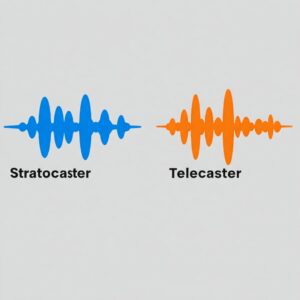
Product Recommendations: Find Your Perfect Match 🛒
Top Telecaster Options in 2025
After testing dozens of models, here are my top recommendations for different budgets:
For beginners and intermediate players:
Fender Player Telecaster combines authentic Fender tone with modern playability at an accessible price point. Its alnico 5 pickups deliver classic Tele twang while remaining versatile enough for various styles. The comfortable “Modern C” neck profile suits a wide range of hand sizes, making it an excellent first serious guitar.
Specs:
- Alder body
- Maple neck with “Modern C” profile
- 22 medium-jumbo frets
- 2 Player Series single-coil Telecaster pickups
- 3-way switch with master volume and tone controls
For professionals and serious enthusiasts:
The Fender American Professional II Telecaster represents the evolution of Fender’s flagship production model. With V-Mod II pickups designed by Tim Shaw, it delivers enhanced dynamics and clarity across all pickup positions. The new “Deep C” neck profile and rolled fingerboard edges provide exceptional playing comfort.
Specs:
- Alder body (ash on certain finishes)
- Maple neck with “Deep C” profile
- 22 narrow-tall frets
- V-Mod II single-coil Telecaster pickups
- Treble bleed circuit maintains clarity when reducing volume
For vintage enthusiasts:
The Fender American Original ’50s Telecaster faithfully recreates the instrument that started it all. With period-correct features like a U-shaped neck profile and vintage-style pickups, it delivers authentic 1950s tone and feel with just enough modern improvements for reliability.
Specs:
- Ash body
- Maple neck with “Thick U” profile
- 21 vintage-tall frets
- Pure Vintage ’52 single-coil Telecaster pickups
- Vintage-style hardware throughout
Top Stratocaster Options in 2025
For beginners and intermediate players:
The Fender Player Stratocaster offers exceptional value with its versatile sound profile and comfortable playability. The trio of Player Series pickups delivers everything from glassy cleans to aggressive leads, making it suitable for nearly any genre.
Specs:
- Alder body
- Maple neck with “Modern C” profile
- 22 medium-jumbo frets
- 3 Player Series single-coil Stratocaster pickups
- 2-point synchronized tremolo with bent steel saddles
For professionals and serious enthusiasts:
The Fender American Ultra Stratocaster represents Fender’s most advanced production model. Its Ultra Noiseless pickups eliminate the traditional single-coil hum while preserving authentic tone. The compound-radius fingerboard and tapered neck heel provide unparalleled playing comfort.
Specs:
- Alder body with contoured heel
- Maple neck with “Modern D” profile and compound radius
- 22 medium-jumbo frets
- Ultra Noiseless single-coil Stratocaster pickups
- Ultra Noiseless Hot single-coil Stratocaster bridge pickup
- S-1 switch for additional pickup combinations
For vintage enthusiasts:
The Fender American Original ’60s Stratocaster captures the magic of the golden era with its period-correct features and attention to detail. From the round-lam rosewood fingerboard to the Pure Vintage ’65 pickups, it delivers all the warmth and character of a vintage instrument without the vintage price tag.
Specs:
- Alder body
- Maple neck with “’60s C” profile
- 21 vintage-tall frets
- Pure Vintage ’65 single-coil Stratocaster pickups
- Vintage-style synchronized tremolo
Comparison Table: Head-to-Head Features 📊
| Feature | Telecaster | Stratocaster |
|---|---|---|
| Body Shape | Flat slab with minimal contouring | Contoured with arm and body relief |
| Pickups | 2 single-coils (typically) | 3 single-coils (typically) |
| Bridge | Fixed with string-through-body | Synchronized tremolo system |
| Neck Profile | Often fuller “U” or “C” shapes | Typically slimmer “C” or “Modern C” shapes |
| Weight | Generally lighter (7-8 lbs) | Generally heavier (7.5-8.5 lbs) |
| Tonal Character | Bright, twangy, aggressive | Versatile, balanced, smooth |
| Pickup Selector | 3-way switch | 5-way switch |
| Price Range | $199 (budget) – $2,500+ (custom) | $199 (budget) – $2,500+ (custom) |
| Signature Sound | Cutting bridge, warm neck | “Quacky” positions 2 & 4, bell-like cleans |
| Main Genres | Country, rock, punk, indie | Blues, rock, funk, surf |
Price Comparison of Recommended Models
| Model | Price Range (2025) | Best For |
|---|---|---|
| Squier Affinity Telecaster | $249-$329 | Beginners, Budget-Conscious |
| Fender Player Telecaster | $799-$849 | Intermediate Players |
| Fender American Pro II Telecaster | $1,699-$1,799 | Professionals, Serious Hobbyists |
| Squier Affinity Stratocaster | $249-$329 | Beginners, Budget-Conscious |
| Fender Player Stratocaster | $799-$849 | Intermediate Players |
| Fender American Ultra Stratocaster | $1,999-$2,099 | Professionals, Recording Artists |
Find Your Perfect Guitar Match Today! 🔍
→ Ready to experience these legendary instruments yourself? Click on any of the highlighted models above to check current pricing and availability on Amazon. Whether you’re drawn to the Telecaster’s twang or the Stratocaster’s versatility, there’s never been a better time to add one of these iconic guitars to your collection! 🎸

Making Your Decision: Practical Considerations 🤔
Budget and Value
While both guitars are available at various price points, there are some considerations:
Entry-Level Options:
- Budget Telecaster-style guitars often deliver tone closer to professional models than budget Stratocasters
- Simpler construction means fewer components that might need upgrading
- Fixed bridges are more forgiving of manufacturing tolerances
Mid-Range Investments:
- The Fender Player Series offers excellent value in both models
- Mexican-made Fenders provide about 85% of the American experience at roughly half the price
- Used market is robust for both, with excellent values available
Premium Purchases:
- American-made models offer refinements in playability and tone
- Custom Shop options allow for personalized specifications
- Vintage instruments continue to appreciate in value
According to Reverb.com’s price guide, both Stratocasters and Telecasters have shown steady appreciation over time, with vintage examples increasing in value by an average of 8-12% annually over the past decade.
Maintenance Requirements
The guitars differ somewhat in their maintenance needs:
Telecaster advantages:
- Fixed bridge requires minimal adjustment
- Simpler electronics with fewer potential failure points
- More forgiving of humidity and temperature changes
- Generally stays in tune better with heavy playing
Stratocaster considerations:
- Tremolo system requires occasional adjustment
- Springs can develop noise over time
- More complex electronics with additional components
- May require more frequent tuning
Guitar tech Dave Schneider notes that a properly set-up Stratocaster can be nearly as stable as a Telecaster, but it requires more initial setup expertise and periodic maintenance to maintain optimal performance.
Modification Potential
Both guitars have thriving aftermarket modification communities:
Telecaster mod potential:
- Extensive pickup replacement options
- Upgraded bridge assemblies
- Pre-wired control plates for quick electronics swaps
- Nashville-style modifications
Stratocaster mod potential:
- Virtually limitless pickup configurations
- Tremolo upgrades (locking systems, better blocks)
- Expanded switching options
- Shielding improvements
According to StewMac’s guitar building supplies, the Stratocaster consistently ranks as the most modified electric guitar, with players often personalizing them to suit specific needs.
Elevate Your Playing Experience With Premium Accessories! ✨
→ Complement your new Fender guitar with professional-quality accessories designed to enhance tone and playability. Click any of the highlighted products to find current deals on strings, cases, and electronics that will help you get the most from your instrument. Don’t settle for ordinary when extraordinary is just a click away! 🎵
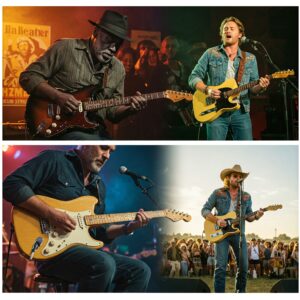
Conclusion: There Is No Wrong Choice 🏆
After examining the Stratocaster vs Telecaster in detail, we arrive at a simple truth: both are exceptional instruments with seven decades of proven excellence. Your choice ultimately depends on your personal preferences, playing style, and the specific musical contexts you find yourself in.
For players seeking a straightforward, reliable guitar with a distinctive voice that cuts through any mix, the Telecaster offers an unmatched combination of simplicity and sonic character. Its no-nonsense design and focused tone have made it the secret weapon of countless studio professionals and performing artists who value clarity and impact.
For musicians requiring greater tonal versatility and expressive capabilities, the Stratocaster provides a broader palette of sounds and the added dimension of its tremolo system. Its ergonomic design and multi-faceted voice have made it the choice of players who need one instrument to cover many bases.
Many experienced guitarists eventually own both, recognizing that these iconic instruments complement rather than compete with each other. As Jeff Beck once remarked in a Fender interview, “They’re different tools for different jobs. The Telecaster tells one truth very loudly, while the Stratocaster tells many truths with more subtlety.”
Whichever you choose, you’ll be playing an instrument that has shaped the sound of popular music and stood the test of time. The “right” choice is simply the one that inspires you to play more and express yourself more fully.
Start Your Guitar Journey Today With These Special Offers! 🚀
→ Don’t miss your chance to own a piece of musical history! Click on any of the featured Stratocaster or Telecaster models above to check the latest pricing and take advantage of Amazon’s fast shipping and customer protection. Your perfect guitar is waiting – make it yours today and join the millions of players who’ve found their sound with these legendary instruments! 🎵
More FAQ
❓ Which is better for blues: Stratocaster or Telecaster?
✅ The Stratocaster offers smoother tones and better tonal variety for blues, while the Telecaster gives a rawer, more twangy sound that suits country-blues styles…
❓ Is a Stratocaster or Telecaster easier to play?
✅ Many players find the Stratocaster more comfortable due to its contoured body and double cutaway, while the Telecaster offers a simpler, more straightforward feel…
❓ Which has more pickup options: Stratocaster or Telecaster?
✅ The Stratocaster typically comes with three single-coil pickups and a 5-way selector, offering more tonal flexibility than the standard two-pickup setup of a Telecaster…
❓ Can a Telecaster sound like a Stratocaster?
✅ While both share Fender’s single-coil DNA, the Telecaster has a brighter, more biting tone. With mods or pickup changes, it can mimic some Strat tones—but not fully replicate them…
❓ Is the Stratocaster or Telecaster better for beginners?
✅ Both are beginner-friendly, but the Stratocaster’s ergonomic shape and wider tonal range make it slightly more versatile for new players exploring different genres…
Recommended for You:
- Guitar Amp vs Multi-effects Pedal: The Ultimate Tone Battle in 2025
- Single Coil vs Humbucker Pickups: The Ultimate Comparison Guide for 2025 – Pros, Cons & Pro Tips
- Solid body vs Hollow body electric guitar: The Ultimate Comparison Guide (2025)
Disclaimer: This article contains affiliate links. If you purchase products through these links, we may earn a small commission at no additional cost to you.
